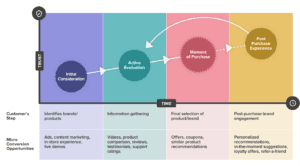
Vivek Lakshman, vice president of product, Chatlets.ai
Your website can make or break your business, particularly if it’s a key sales channel. But what if you build your site and no one purchases or registers? Will you be able to figure out why visitors didn’t convert and fix it?
Most of us make educated guesses about website visitors to try and deliver experiences that produce conversions. But making the wrong guesses can result in low conversion rates and missed sales.
There must be a better way. One avenue is to dive into research to uncover what drives or prevents your customers from converting. This can take a lot of time and money. A simpler alternative is to take a page from behavioral science and focus on understanding what smaller actions on your website ultimately result in the conversions that contribute to your bottom line. Savvy marketers are “thinking small” and developing micro-conversion strategies that capitalize on these incremental steps.
Micro-conversions along the customer journey
Effective marketing involves providing consumers with the right content, action or incentive at the right moment to persuade them to do something. What is “right” for a particular consumer can depend on where they are in the buyer journey.
In each of these stages, we tend to act a certain way; for example, in the initial consideration phase, we do basic research. This may consist of a series of small actions—or micro-conversions—on a website, such as reading a blog post or watching a video. Different micro-conversions can elicit different reactions from different consumers. But overall, the objective is to spur consumers to take action.

Micro-conversion opportunities along the customer journey.
Another way to think about micro-conversions is by type. According to UX experts at the Nielsen Norman Group, micro-conversions can be categorized as “process milestones,” steps that move consumers closer to purchase, such as doing a demo, and “secondary actions,” or activities that indicate interest in converting, such as downloading a brochure.
Why micro-conversions count
Research shows that the macro-conversion rate (i.e., purchase) on ecommerce sites is about 3%. By focusing only on macro conversions, you miss out on understanding the intent of 97% of visitors—potential customers—and what content persuades them to convert.
Offering micro-conversions on your site also gives you a combination of levers to pull to test what works to increase macro-conversions. In other words, when your site is not performing as expected, micro-conversions allow you to look under the hood to determine why.
Micro-conversions can help you:
- Deeply understand user behavior and intent
- Understand what steps are needed to achieve macro-conversion
- Enable micro-persuasion tactics, testing and optimization
- Improve user experience and increase personalization
5 steps to develop a micro-conversion strategy
According to a recent Hubspot report, more than two-thirds of marketers say converting leads is their top priority—but in my experience, most aren’t focused on optimizing micro-conversions on their websites. Taking a more granular view could provide a competitive edge for brands—particularly with new technologies including conversational interfaces and personalization platforms.
Step 1: Quantify your website goals
To measure outcomes, you need to know your macro- and micro-conversion goals. You probably know your overall conversion goals, but micro-conversion goals might be a little hazier. Steps 3-4 can help you identify key micro-conversions, and then you can assign baseline goals.
Step 2: Identify audiences
To clarify what micro-conversion content might be effective, you need to know your audiences. Creating customer personas is a great way to develop content for real people versus a demographic. Your personas can include demographic information, but also psychographic details like what’s important to them or what keeps them up at night.
Step 3: Inventory existing micro-conversions
You probably have some effective micro-conversions already on your website. To establish your baseline, you can comb through your website to understand what micro-conversions already exist, and then determine what else might persuade or trigger visitors to convert.
Step 4: Offer micro-conversions at each stage of the buyer journey
It helps to keep the buyer journey in mind to identify what additional micro-conversions may be needed to influence visitors’ decisions as they progress through the stages of consideration, evaluation and purchase.
Step 5: Measure and optimize
It will be important to closely monitor micro-conversions and compare your before and after conversion rates. Tracking will indicate opportunities to tweak and see what works best.
Persuasion has been called an art. But it’s also a science that can be systematically applied by marketers to influence behavior. Behavioral science experts like BJ Fogg at Stanford agree that to get people to behave a certain way (e.g., eat healthier), we must make smaller actions easier (e.g., have produce delivered to my house) that will sustain motivation and lead to larger behavior changes.
You can apply the same techniques on your website. When visitors arrive, it’s up to you to make it easy for them to get what they need by leveraging micro-conversions that persuade and prompt them to convert.
Chatlets.ai provides technology designed to enable personalized micro-conversions through conversational interfaces.
Favorite
